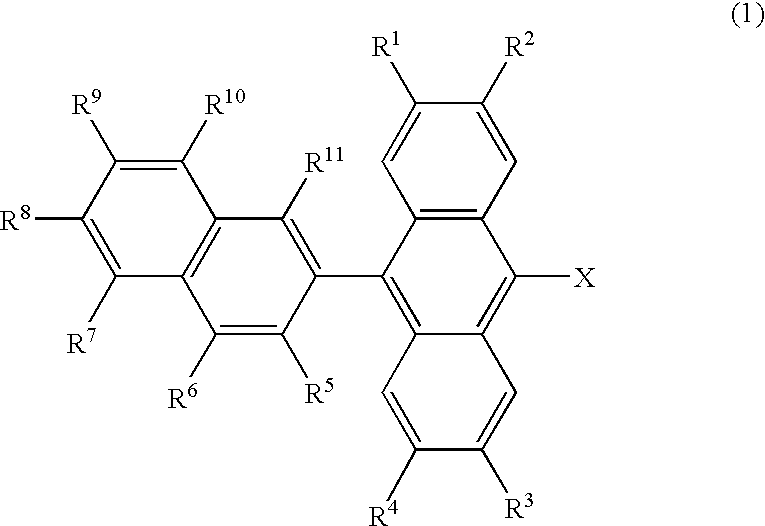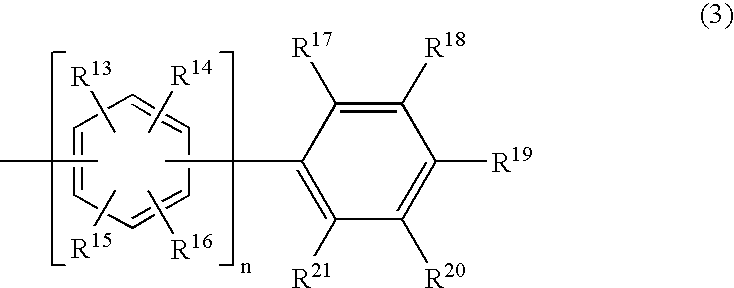Organic Electroluminescent Device
a technology of electroluminescent devices and organic materials, which is applied in the direction of thermoelectric devices, discharge tube luminescnet screens, natural mineral layered products, etc., can solve the problems of inferior ability to form thin films and high crystallizability, and achieve excellent heat resistance, low driving voltage, and high emission efficiency
- Summary
- Abstract
- Description
- Claims
- Application Information
AI Technical Summary
Benefits of technology
Problems solved by technology
Method used
Image
Examples
example 1
Synthesis of Compound (56)
[0079] 9-Bromo-10-(m-terphenyl)anthracene 4.85 g and β-naphthyleneboronic acid 2.58 g were dissolved in a mixed solvent 100 ml (toluene / ethanol=4 / 1) of toluene and ethanol under nitrogen atmosphere, and tetrakis(triphenylphosphine)palladium (0) 0.58 g was added thereto, followed by stirring the solution for 5 minutes. Then, a sodium carbonate aqueous solution 10 ml of 2M was added thereto, and the solution was refluxed for 3 hours. After finishing heating, the reaction liquid was cooled down to separate an organic layer, and this was washed with saturated brine and then dried on anhydrous magnesium sulfate. A solid matter obtained by removing the desiccant and distilling off the solvent under reduced pressure was subjected to column refining (solvent: heptane / toluene=3 / 1) with silica gel, and then it was refined by sublimation to obtain 3.5 g of the targeted compound. The structure of the compound (56) was confirmed by an MS spectrum and NMR measurement. Th...
example 2
Synthesis of Compound (23)
[0080] 9-Bromo-10-(β-naphthyl)anthracene 3.83 g and m-quaterphenyl-3-boronic acid 3.85 g were dissolved in a mixed solvent 100 ml (toluene / ethanol=4 / 1) of toluene and ethanol under nitrogen atmosphere, and tetrakis(triphenylphosphine)palladium (0) 0.58 g was added thereto, followed by stirring the solution for 5 minutes. Then, a sodium carbonate aqueous solution 10 ml of 2M was added thereto, and the solution was refluxed for 10 hours. After finishing heating, the reaction liquid was cooled down to separate an organic layer, and this was washed with saturated brine and then dried on anhydrous magnesium sulfate. A solid matter obtained by removing the desiccant and distilling off the solvent under reduced pressure was subjected to column refining (solvent: heptane / toluene=3 / 1) with silica gel, and then it was refined by sublimation to obtain 4 g of the targeted compound. The structure of the compound (23) was confirmed by an MS spectrum and NMR measurement. ...
example 3
Synthesis of Compound (27)
[0081] 9-Bromo-10-(β-naphthyl)anthracene 3.83 g and o-quaterphenyl-3-boronic acid 3.85 g were dissolved in a mixed solvent 100 ml (toluene / ethanol=4 / 1) of toluene and ethanol under nitrogen atmosphere, and tetrakis(triphenylphosphine)palladium (0) 0.58 g was added thereto, followed by stirring the solution for 5 minutes. Then, a sodium carbonate aqueous solution 10 ml of 2M was added thereto, and the solution was refluxed for 10 hours. After finishing heating, the reaction liquid was cooled down to separate an organic layer, and this was washed with saturated brine and then dried on anhydrous magnesium sulfate. A solid matter obtained by removing the desiccant and distilling off the solvent under reduced pressure was subjected to column refining (solvent: heptane / toluene=3 / 1) with silica gel, and then it was refined by sublimation to obtain 3 g of the targeted compound. The structure of the compound (27) was confirmed by an MS spectrum and NMR measurement. ...
PUM
| Property | Measurement | Unit |
|---|---|---|
| thickness | aaaaa | aaaaa |
| thickness | aaaaa | aaaaa |
| temperature | aaaaa | aaaaa |
Abstract
Description
Claims
Application Information
 Login to View More
Login to View More - R&D
- Intellectual Property
- Life Sciences
- Materials
- Tech Scout
- Unparalleled Data Quality
- Higher Quality Content
- 60% Fewer Hallucinations
Browse by: Latest US Patents, China's latest patents, Technical Efficacy Thesaurus, Application Domain, Technology Topic, Popular Technical Reports.
© 2025 PatSnap. All rights reserved.Legal|Privacy policy|Modern Slavery Act Transparency Statement|Sitemap|About US| Contact US: help@patsnap.com



